NUTRITION IN PLANTS for Class 7 SCIENCE
INTRODUCTION
Jaise ki class 6 mein hamne padha ki food kya hota hai, uske components kya hote hai etc. To food hamari body ke liye ek fuel ka kaam karta hai jaise ki kisi bhi vehicle ko chalane ke liye hame fuel ki jarurat hoti hai. Eg- Car mein jab tak hum petrol nahi dalte tab tak usko chalaya nahi ja sakta. Theek isi tarah jab tak hum khana nahi khate tab tak hamari body mein bhi work karne ki energy nahi hoti. Food sabhi living organisms ke jinda rehne ke liye aur unki body ki growth ke liye bahut hi important element hai. Hamne class 6 mein yeh bhi padha ki food mein kuchh components bhi present hote hai. Eg- carbohydrate, proteins, vitamins, minerals and fats. Food mein jitne bhi components present hote hai unko hum nutrients kehte hai. Ab iss chapter mein hum padhenge ki nutrients kya hote hai, nutrition kya hai, modes of nutrition kya hote hai, photosynthesis kya hai aur soil mein nutrients kaise replenish karte hai, insectivorous plants kya hote hai etc.
Let's understand Nutrients and Nutrition
NUTRIENTS- Aise substances jo hamari body ko energy dete hai, hamari body ki growth mein help karte hai aur hamari body ke andar hone wali sabhi processes ko karne mein help karte hai unko hum nutrients kehte hai. Eg- carbohydrates, proteins, fats, vitamins and minerals. Yeh sabhi nutrients hame fruits, vegetables, pulses aur dairy products etc. se milte hai.

Hamari body ko healthy rakhne ke liye hame yeh sabhi nutrients roz sahi maatra (amount) mein lene chahiye. Aap niche di gayi figures mein bhi dekh sakte hai ki konse components hame kitni maatra (amount) mein khane chahiye kyunki har ek nutrient ka alag function hota hai aur yeh sab milkar hamari body ko healthy rakhne mein help karte hai. Niche figures mein hum dekh sakte hai ki konsa nutrient hame kya provide karta hai aur wo hamari diet mein kitna percent hona chahiye.

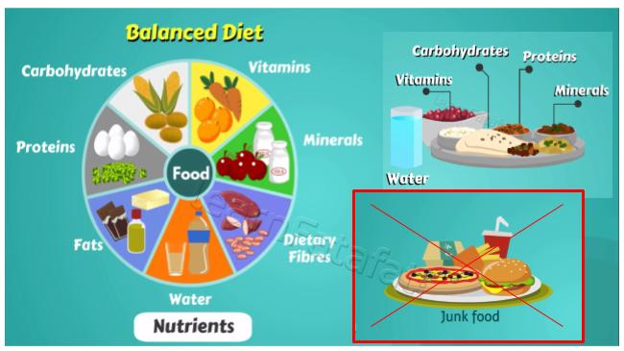
NUTRITION- Yeh organisms ka food ko paane ka aur usko apni body mein use karne ka tareeka hai (mode). Yeh nutrients hame alag alag sources se milte hai jaise ki fruits, vegetables, pulses etc.
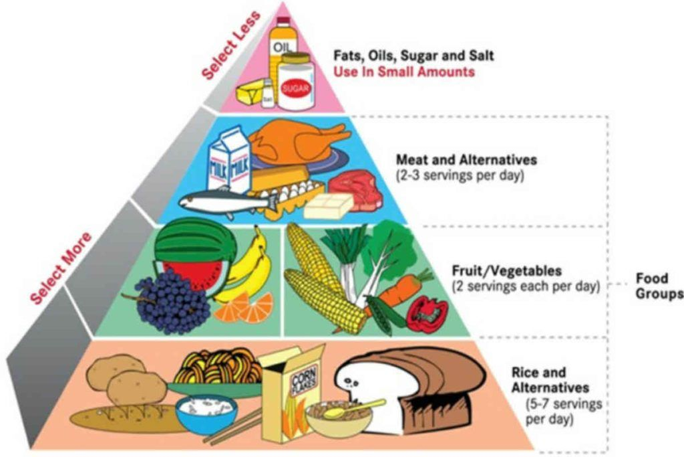
Sabhi organisms ko jinda rehne ke liye food to chahiye lekin kya kabhi socha hai yeh food aata kaha se hai?
Kuchh organisms apna khana khud banate hai aur kuchh apna khana dusre organisms se lete hai. Toh iske liye hum padenge mode of nutrition.
Types Of Organisms:
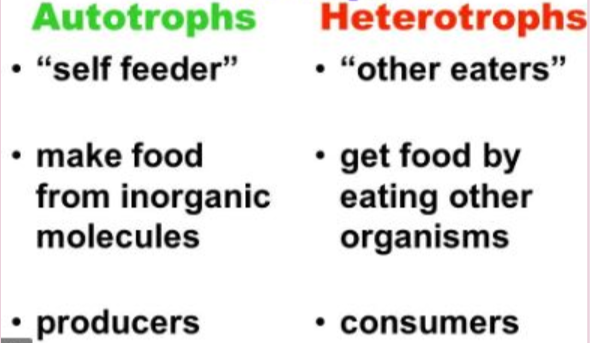
MODE OF NUTRITION
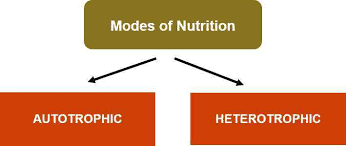

To jaisa ki hamare chapter ka naam hai Nutrition In Plants, so plants apna khana khud banate hai isliye unka mode of nutrition autotrophic mode of nutrition hota hai. Ab hum padhenge ki wo apna khana kaise banate hai- wo apna khana photosynthesis ke through banate hai.
POINT 1
Nutrients- Those components of food that are essential for our body are called nutrients.
Nutrition- Nutrition is the method of taking and consuming food by living organisms.
Macronutrients- The nutrients which are needed by plants in a large amount are called macronutrients.
Micronutrient- The Nutrients which are needed by plants in a very small amount are called micronutrients.
Autotrophs- The organisms which synthesize their own food by the process of photosynthesis are called autotrophs.
Heterotrophs- The organisms which depend on other organisms for their food and survival are called heterotrophs.
PHOTOSYNTHESIS — Food Making Process in Plants
Jis process se plants apna khana banate hai usse photosynthesis kehte hai.
“ The process by which green plants prepare their own food with the help of inorganic materials like carbon dioxide, water in the presence of sunlight and chlorophyll is known as photosynthesis.”
Plants apna khana leaves mein banate hai kyunki wahan ek green colour ka pigment present hota hai jisko hum chlorophyll kehte hai aur wo energy ko absorb karta hai, isliye leaves ko food factory of plants bhi kehte hai.
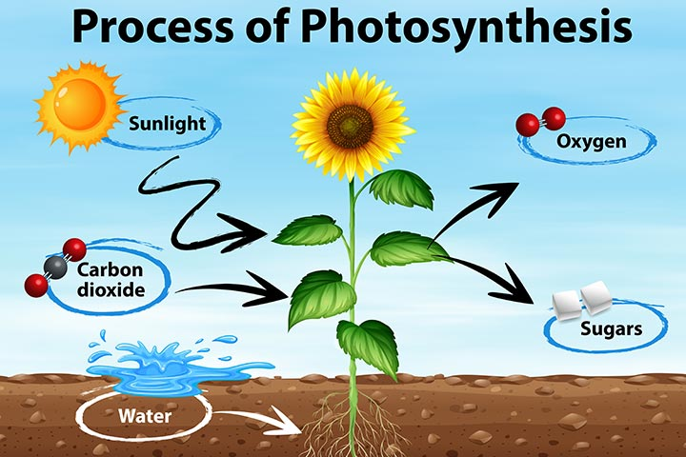
Plants mein photosynthesis sirf leaves mein hi nahi balki baaki green parts mein bhi hota hai jaise ki green stems mein bhi hota hai kyunki unme bhi chlorophyll present hota hai. Lekin ye process kaise hoti hai? Plants yeh material kaha se lete hai?
Plants ko photosynthesis ke liye yeh sab cheejein chahiye hoti hai-
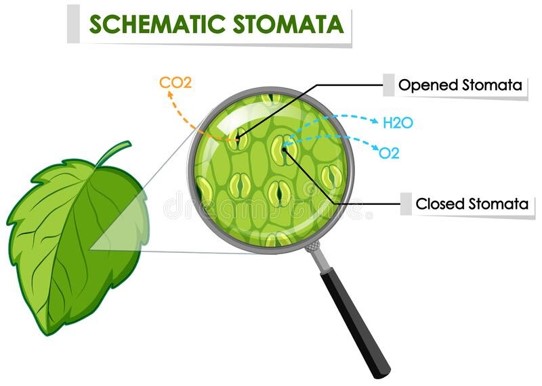
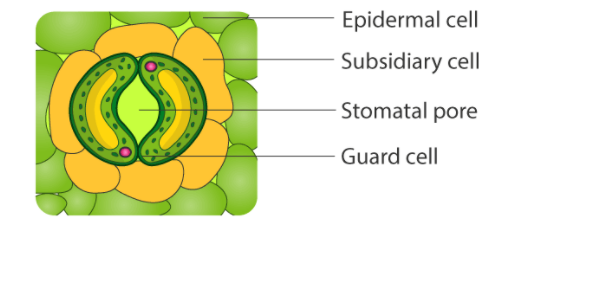
Stomata ke bahar usko protect karne ke liye guard cells present hote hai jaisa ki hum niche figure mein dekh sakte hai. Yeh guard cells open aur close hote rehte hai. Jab yeh open hote hai to CO2 andar jaati hai aur yeh swell ho jaate hai; Jab yeh close hote hai to O2 aur water bahar nikal jaate hai aur yeh cell shrink ho jaate hai.
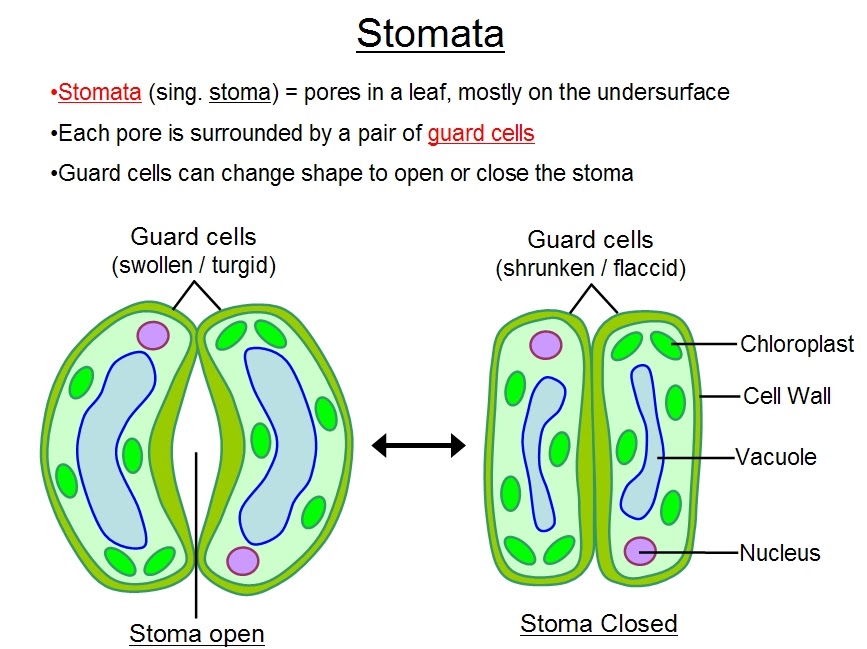
Process of photosynthesis-
Plants ki leaves mein stomata present hote hai aur iske andar chlorophyll present hota hai. Chlorophyll ke andar chloroplast hote hai jo sun ki light energy ko absorb karke usko carbon dioxide aur water ke saath combine karke glucose (food) banata hai aur oxygen banata hai.
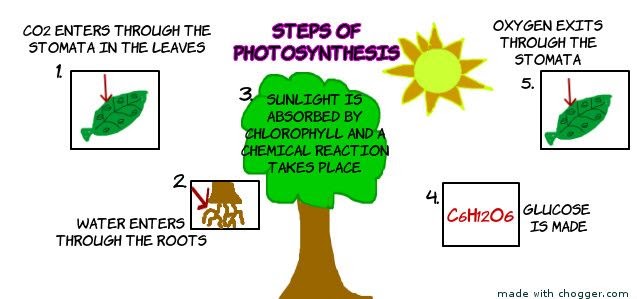
Ab khana toh plants ne photosynthesis ki help se bana liya lekin hame kaise pata chlega ki plants ne khana bnaya ya nahi? Isko pata lagane ke liye hum ek activity karte hai.
Activity
* Hum ek potted plant lenge.
* Uski ek leaf par black paper achhe se laga denge. Jaisa ki aap figure mein dekh sakte hai.
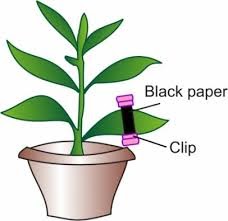
* 2 din ke liye usko sunlight mein rakhenge.
* Fir uski leaf ko lenge jispar hamne black paper lagaya tha.
* Puri leaf par iodine solution dalenge aur kuch der ke liye wait karenge.
* Ab hum figure mein dekhte hai ki jaha par hamne black paper lgaya tha uske alawa puri leaf blue-black color ki hogyi hai.
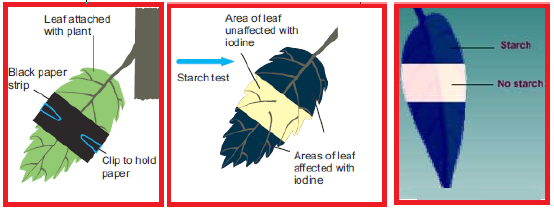
* Iska matlab hai ki jaha hamne black paper lagaya tha waha sunlight na phonch paane ki wajah se leaf waha khana nahi bana payi isliye waha starch absent tha.
Note: Agar carbon dioxide, water, sunlight ya chlorophyll mein se kuchh bhi absent hoga toh plants apna khana nahi bana payenge.
Ab kuchh aise plants bhi hote hai jinme chlorophyll present nahi hota jiski vajah se wo apna khana khud nahi bana paate. Aise plants ko bhi hum heterotrophs kehte hai. Iske baare mein hum aage padhenge.
POINT 2
Photosynthesis- Green plants make their own food with inorganic substances like carbon dioxide and water in the presence of sunlight and chlorophyll. This process is called photosynthesis.
Stomata- The tiny openings present on the surface of leaves for gaseous exchange and transpiration are called stomata.
Chlorophyll- The green pigment present in the leaves is called chlorophyll.
Other Modes of Nutrition in Plants

Saprophytic nutrition- Yeh ek aisa mode of nutrition hota hai jisme organisms apna food dead aur decaying organisms se lete hai.

Parasitic Nutrition- Yeh ek aisa mode of nutrition hai jisme organisms apna food dusre living organisms (host) par rehkar, unko harm kiye bina lete hai.
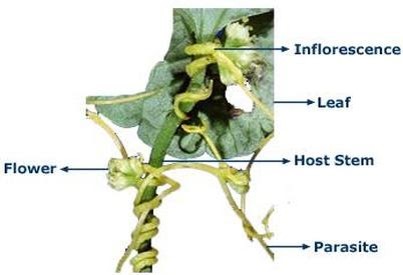
Holozoic Nutrition- Yeh ek aisa process of nutrition hai jisme organisms apna khana body ke andar le jakar pachate (digest) hai aur usse energy lete hai. Eg - Human beings, Dog, Cat sabhi yahi mode of nutrition follow karte hai.
Lekin yeh mode of nutrition animals mein paya jata hai isliye iske baare mein hum next chapter mein padhenge.
POINT 3
Autotrophic Mode Of Nutrition- The method of nutrition in which the organisms synthesize their food itself, is called autotrophic mode of nutrition.
Parasites- The organisms which live on the body of the host for their nutrition are called parasites.
Saprophytes- The organisms which lives on the dead and decaying matter are called sapro- The small holes present on the surface of leaves by which gaseous exchange takes place are called stomata.
Holozoic Mode Of Nutrition- The mode of nutrition in which an organism ingest the complex organic food material followed by digestion and then absorption of food in the body cells is known as holozoic mode of nutrition.
Heterotrophic Mode Of Nutrition- Animals and most other organisms consume food synthesized by plants. They are called heterotrophic mode of nutrition.
Saprophytic Mode Of Nutrition- The method of nutrition in which the organisms obtain their food by dead-decay substances, this type of nutrition is called saprophytic mode of nutrition.
Parasitic Mode Of Nutrition- The method of nutrition in which the organism depends on food made by other organisms, this type of nutrition is called parasitic mode of nutrition.
Insectivorous Plants
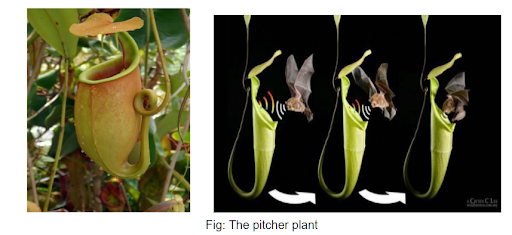

Symbiotic Relationship
Aise organisms jo ek dusre ke saath rehte hai aur apna nutrition aur shelter (rehne ki jagah) dono share karte hai.
Eg-1. Kuchh fungi trees ki roots mein rehti hai, tree fungus ko nutrients deta hai aur badle mein fungus soil mein se water aur nutrients ko tree ke paas lekar jaata hai. Yeh association dono ke liye hi fayde ki (beneficial) hoti hai.
2. Iska ek aur bahut common example hai Rhizobium bacteria. Yeh leguminous plants (eg- peas, gram, moong) ki roots mein rehte hai. Plants soil se direct nitrogen nahi le paate isliye ye plants ke liye Nitrogen fixation ka kaam karte hai aur badle mein inko plant se food aur shelter milta hai.
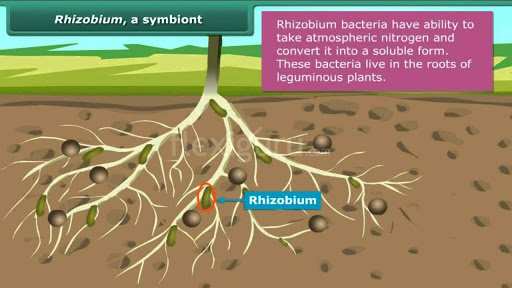
HOW NUTRIENTS ARE REPLENISHED IN THE SOIL
Difference between Autotrophs and Heterotrophs

Difference between Saprophytes and Parasites
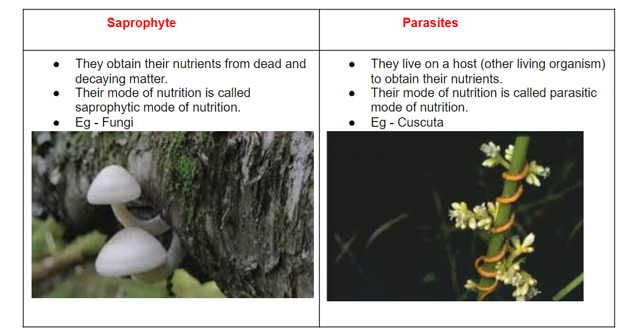
POINT 4
Nitrogen Fixation- It is a biological process in which nitrogen fixing bacterias convert nitrogen gas into a usable form for plants and other microbes.
Symbiosis- Mode of nutrition in which two different individuals associate with each other to fulfil their requirement of food is called symbiosis.
Insectivorous Plants- A plant which fulfills its nitrogenous needs by eating insects is called an insectivorous plant.
SUMMARY
1. All organisms need food and utilise it to get energy for growth and maintenance of their body.
2. Green plants synthesise food for themselves by the process of photosynthesis. They are autotrophs.
3. Plants like Cuscuta are parasites. They take food from the host plant.
4. Plants use simple chemical substances like carbon dioxide, water and minerals for the synthesis of food.
5. Chlorophyll, water, carbon dioxide and sunlight are the essential requirements for photosynthesis.
6. Complex chemical substances such as carbohydrates are the products of photosynthesis.
7. Solar energy is absorbed by the chlorophylls present in leaves/plants.
8. Oxygen is produced during photosynthesis. Oxygen released in photosynthesis is utilised by living organisms for their survival.
Many fungi derive nutrition from dead and decaying matter. They are saprotrophs.
9. A few plants and all animals are dependent on others for their nutrition and are called heterotrophs.
